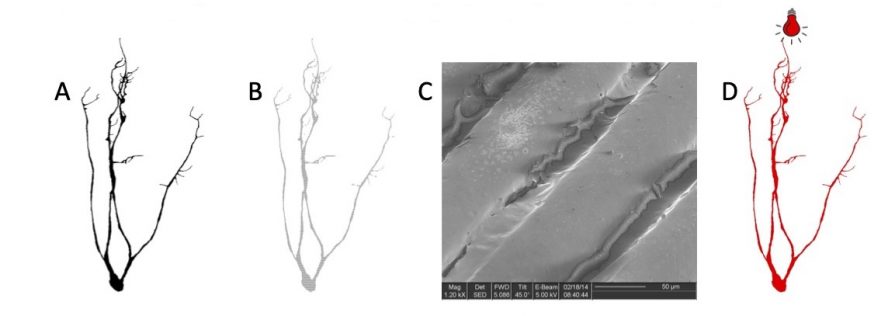You’ll find here more information about Greg Dunn’s pop-up exhibition and the process of microetching.
Descriptions
CORTICAL CIRCUITBOARD
Aluminized microetched print with ceramic printed glass
61cm X 81cm, 2012-13
Greg Dunn and Brian Edwards
Cortical Circuitboard features a stylized array of cortical neurons that are arranged into the layered structure of the cerebral cortex. It incorporates aesthetic motifs drawn from circuitboard design into the neural landscape to draw parallels between the chaos of a biological brain and the order of an electronic one.
This piece features the first example of Dr. Edwards’ animation algorithm. Using visual information built into the design, Dr. Edwards’ algorithm calculates the precise angle necessary at any coordinate on the microetching to reflect light to the viewer standing at a given position. This allows light to reflect off of the surface in specific ways, giving us the ability to depict animations within each neuron. As the viewer walks past the microetching the neurons fire action potentials, creating a finished piece whose circuit dynamics represent the actual firing patterns found within the cerebral cortex.
BRAINBOW HIPPOCAMPUS
Aluminized microetched print with ceramic printed glass
61cm X 81cm, 2014
Greg Dunn and Brian Edwards
This piece is an ode to one of the most iconic regions in neuroanatomy, and one of the regions which defines our individuality and humanity.
Brainbow Hippocampus depicts the actively firing anatomy and complex circuitry of the hippocampus, the hub of learning, memory, and integration of experiences in the brain. This is the region most responsible for our rich and realistic imagination as well, and is indispensable for our ability to sequence events together.
When lit with multicolored lamps, the Brainbow Hippocampus microetching also illustrates the brainbow genetic technique wherein scientists splice in multicolored fluorescent proteins into every neuron in the brain in order to make the identification and mapping of neurons easier. Similar to this technique, a few different colors of light can mix onto the etching in many different ways and can produce a spectacular variety of colors. As the color of the etching is entirely dependent on the lighting, literally thousands of multicolored palettes are possible.
PRANAYAMA
Aluminized microetched print with ceramic printed glass
61cm X 81cm, 2015
Greg Dunn and Brian Edwards
Pranayama is an exploration of the internal state during yogic breathing exercises called pranayamas.
As the viewer moves from the left to the right, light reflecting off of the etching’s millions of microscopic mirrors animates the breath of the meditating figure and the movement of prana, the subtle sensations of energy that become pronounced through practice. This dynamically reflective microetching depicts the movement of prana in the body as the viewer walks around it. When walking from left to right, the “inhale,” prana is withdrawn from the extremities, into the central channel, and upwards. When walking from right to left, the “exhale,” the prana moves back down the central channel and into the extremities. The microetching “breathes” as the viewer walks past it, providing a reminder to bring the mind back to a position of awareness.
Pranayama is a bit of a departure from my more directly anatomical work on the nervous system, one that explores alternative ways of interpreting the mind and brain. It is directly inspired by my practice of meditation and experiences inside my sensory deprivation tank and is a map of the perceptions felt after years of practicing pranayama.
BRAIN MACHINE INTERFACE
Aluminized microetched print with ceramic printed glass
61cm X 81cm, 2016
Greg Dunn and Brian Edwards
The animated microetched print Brain Machine Interface is about the interconnected future of the human brain. It simultaneously comments on both the amazing benefits and potential dangers of these powerful neural interfacing technologies.
As the viewer moves from the left to the right of the etching, neurons synapse into and create a face initially with a terrified expression. This symbolizes the average person’s fear regarding the future of human/machine evolution, particularly concerning the more invasive implant technologies currently being utilized. The etching then transitions into an expression of awe, relief, and joy upon their successful implementation – restoring lost functionality, enhancing human cognition and communication, greatly increasing our access to information, etc. Finally, circuits spray out of the face and symbolize this evolution toward enhancing human potential.
Upon viewing the etching from right to left, however, the opposite progression unfolds: humanity achieving a godlike state through the use of these technologies only to fall victim to unwise misuses that lead to a degradation of the human soul.
PHOTOSYNTHESIS
Aluminized microetched print with ceramic printed glass
61cm X 81cm, 2017
Greg Dunn and Brian Edwards
Photosynthesis is a work combining both art and science to simulate how water and nutrients are transported through the vasculature of a leaf in fractal like, pulsating patterns. These processes represent basic functions of plant physiology which are invisible to the unaided eye.
SELF REFLECTED
Aluminized microetched print with ceramic printed glass
61cm X 81cm, 2014-2019
Greg Dunn and Brian Edwards
Self Reflected is an intricate artistic and scientific depiction of the human brain. Through its meticulously researched and etched reflective animations depicting the collective activity of 500,000 neurons at once, it shows you what is happening in your own brain as you are looking at the piece of art. It was created in collaboration with a team of artists, neuroscientists, neurologists, and optical and electrical engineers to bring a sagittal slice of the human brain to life.
Self Reflected was created to elucidate the nature of human consciousness, bridging the connection between the three pound macroscopic brain and the microscopic behavior of neurons. It is here to remind us that the most marvelous machine in the known universe is at the core of our being and is the root of our shared humanity.
SPINAL CORD
Aluminized microetched print with ceramic printed glass
81cm X 107cm, 2021-2022
Greg Dunn and Brian Edwards
Spinal Cord is a highly detailed rendering of a cross section of the human spinal cord. This image was made entirely from scratch, deeply informed by the neuroscientific literature and the neuroscientific literature and designed to be an attractive piece of fine art as well as an accurate atlas of both anatomy and connectivity.
This artwork is designed to give the viewer a comprehensive understanding of the complex anatomical details of this region and how information travels through the cord. In particular, I wanted to emphasize the complexity of the transverse white matter regions and how signals transition into and out of the cord from the brain and extremities. Information travels through the inputs in the dorsal ganglia (neurons at the top of the etching), is processed in the butterfly-shaped gray matter regions in the central cord, and through computations with interneurons and afferent/efferent signals from adjacent regions of the transverse white matter tracts leads to signal outputs through the ventral cord that execute movements.
The spinal cord is the information superhighway connecting our brains to our bodies, an indispensable organ and masterpiece of evolution, as fundamental to our existence as our own brains.
ACTION POTENTIAL
Aluminized microetched print with ceramic printed glass
61cm X 81cm, 2017
Greg Dunn and Brian Edwards
Action Potentials are the electrical communications between neurons and are one of the foundational principles on which the brain operates. Action Potential is an animated microetching that simulates how a neuron receives and integrates incoming signals from connected neurons to trigger it’s own action potential. Incoming action potentials from the small neurons hit the dendrites of the large neuron. The electrical charges from these many small inputs build up through the large neuron’s dendrites. When these signals simultaneously reach the cell body, they trigger the large neuron to fire its own action potential. While this piece is a study of a neuron’s ability to fire, it is also an artistic experiment exploring the explosive beauty of the process. Action potentials are the fundamental processes by which we think, feel, taste, and accomplish every task our brain carries out.
Reflective Microetching – how it’s made?
Reflective microetchings are made via a combination of organic painting techniques, digital processing, photolithography, gilding, and strategic lighting design.
Images are A) painted using a technique wherein ink is blown around on paper using a specially designed tool, B) scanned into the computer where they are assigned a periodic and directional hatching pattern of specific angle then printed on a transparency, and C) engraved into a photoresist using UV light such that the tiny lines in image B become a three dimensional relief in the surface of the resist (micrograph of a microetching at 1200X magnification), and D. the microetching is lit such that the original neuron will be illuminated through light bouncing off of the tiny engraved ridges.

E) complex images composed of many neurons or other objects can be digitally assembled as individual units and F) given different angles of hatching that will eventually result in them reflecting light originating from different angles. When printed on a transparency , photoengraved, and gilded, these hatching patterns give a complex field of angles on the surface of the microetching G), 120X magnification. H) When specific light sources are placed around the microetching, light will reflect toward the viewer’s eye when the light rays hit the engraving at or close to a perpendicular angle. Having different directions of engraving allows many colors to be reflected, and those colors change as the viewer walks around the microetching.






